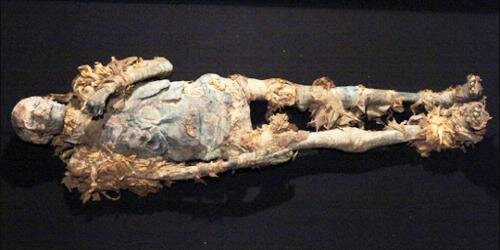|
|
||||||||
|
|
find of the century? For best results we recommend you maximise this browser window STOP PRESS: Wednesday 27th June 2007 - mummy of Hatshepsut discovered? Egyptologists say they have identified the 3,000-year-old mummy of Hatshepsut, Egypt's most powerful female ruler. Following a year long investigation by Dr Zahi Hawass, secretary general of the Supreme Council of Antiquities, the official announcement of the discovery was made at a packed news conference in Cairo. It is being billed as the biggest archaeological find in Egypt since the 1922 discovery of Tutankhamen's tomb. Archaeologists hope the mummy, which has lain unrecognised for decades, will yield clues about the mystery of her death and subsequent disappearance.
The study was funded by the US television channel Discovery which is to broadcast a documentary on the subject in July. The film follows a team of top forensic experts and archaeologists led by Dr Hawass, as they use the full range of forensic technology to identify Hatshepsut. The investigative journey of Dr. Hawass and his team led them through the massive crypts beneath Egypt and into the depths of the Cairo Museum. Using knowledge of royal Egyptian mummification and clues from two known tombs linked to Hatshepsut, the team narrowed their search for Hatshepsut to just four mummies from thousands of unidentified corpses. Computed tomography (CT) scans allowed the scientists to link distinct physical traits of the Hatshepsut mummy to that of her ancestors. The search was further narrowed to two possibilities — both from the tomb of Hatshepsut's nanny — but the final clue lay within a canopic box inscribed with the female Pharaoh's name. A scan of the box found a tooth that, when measured, perfectly matched a missing upper molar in one of the two mummies. Difficult process DNA testing on the 3,000-year-old mummy and mummies from Hatshepsut's family will be the next step to reach conclusive evidence. Dr Hawass has set up a DNA lab near the museum with an international team of scientists to verify the identification. Egyptian molecular geneticist Yehia Zakaria Gad told reporters that preliminary mitochondrial DNA showed “encouraging” results to prove a relationship between the mummy and her ancestor, Ahmose Nefertari.
The mummy was found in Tomb KV60, said to be one of the more perplexing tombs in the Valley of the Kings because it contained two unidentified mummies, both of them women. The tomb was first discovered by Howard Carter in 1903, but it had been ransacked in antiquity and he resealed it. It was re-opened in 1906 and one mummy was removed and identified as Sit-ra, royal nurse of Hatshepsut. The mummy now said to be of Hatshepsut herself was left behind and did not see the light again until it was rediscovered in 1989 by Egyptologist Donald Ryan, an archaeologist at Pacific Lutheran University in Tacoma, Washington. Ryan was struck by the pose and quality of mummification of the second mummy. "It was striking, it was what many believe to be a royal female pose: left arm bent across the chest with the left hand clenched, right arm straight alongside the body. I've always felt that this was a royal mummy, and possibly Hatshepsut, but there was no evidence in the tomb to prove who this mummy might be," he told Discovery News. Ryan also found the smashed remains of a once gold-gilded coffin face-piece that had a notch for a false beard, "suggesting a male or royal association, which would be curious in the tomb of two women, especially if they were both nurses." Courtesy of the BBC News and Discovery News |
|||||||
|
||||||||


